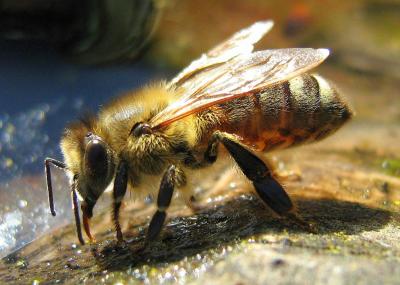There are multiple reasons for the Colony Collapse Disorder (CCD).
Here is another one from Germany:
Honey Bees starve to death in the middle of summer.
“The bees in Germany suffer of food deprivation in the middle of summer and would die of hunger, if they would not be kept alive with sugared water. Food scarcity in nature is dramatic,” …
German article:
Honigbienen verhungern mitten im Sommer
“Die Honigbienen in Deutschland leiden mitten im Sommer an Futtermangel und würden verhungern, wenn sie nicht vom Imker mit Zuckerwasser am Leben erhalten würden. „Der Futtermangel in der Natur ist dramatisch“ erklärt Imkermeister Günter Friedmann, Sprecher der biodynamischen Demeter Imker und Träger des Förderpreises ökologischer Landbau. Beobachtungen an seinen eigenen Bienenvölkern und beunruhigende Meldungen von Imkerkollegen aus ganz Deutschland, veranlassen ihn, jetzt einen Alarmruf zu starten..„ Wenn nicht rasch ein Umdenken und ein neues Handeln in der Landwirtschaft erfolgt, werden wir stumme Sommer erleben – und sehen, dass die Bienen für die Bestäubung und damit auch für die Ernten unersetzlich sind“.
“Friedmann ist seit 30 Jahren Berufsimker, aber „ mit einer solchen Situation wurde ich noch nie konfrontiert“ betont er,“ obwohl sich diese Entwicklung eigentlich seit mehreren Jahren anbahnt und auch zu den Bienenverlusten der letzten Jahre beigetragen hat“ Nach der Rapsblüte, Mitte bis Ende Mai, beginnt für die Bienen in vielen Regionen Deutschlands eine Zeit des Mangels und oft auch des Hungerns. Gerade in den Jahren, in denen es aus dem Wald keinen Honig zu gewinnen gibt, wird deutlich, dass auf den Feldern und Wiesen mittlerweile zu wenig blüht, um den Insekten ausreichend Nahrung zu bieten.”
Full article: Naturkost

A new study shows that heat can produce a potentially toxic substance in high-fructose corn syrup that can kill honeybees and may also threaten human health.
Researchers have established the conditions that foster formation of potentially dangerous levels of a toxic substance in the high-fructose corn syrup (HFCS) often fed to honey bees. Their study, which appears in ACS’ bi-weekly Journal of Agricultural and Food Chemistry, could also help keep the substance out of soft drinks and dozens of other human foods that contain HFCS. The substance, hydroxymethylfurfural (HMF), forms mainly from heating fructose.
In the new study, Blaise LeBlanc and Gillian Eggleston and colleagues note HFCS’s ubiquitous usage as a sweetener in beverages and processed foods. Some commercial beekeepers also feed it to bees to increase reproduction and honey production. When exposed to warm temperatures, HFCS can form HMF and kill honeybees. Some researchers believe that HMF may be a factor in Colony Collapse Disorder, a mysterious disease that has killed at least one-third of the honeybee population in the United States.
The scientists measured levels of HMF in HFCS products from different manufacturers over a period of 35 days at different temperatures. As temperatures rose, levels of HMF increased steadily. Levels jumped dramatically at about 120 degrees Fahrenheit. “The data are important for commercial beekeepers, for manufacturers of HFCS, and for purposes of food storage. Because HFCS is incorporated as a sweetener in many processed foods, the data from this study are important for human health as well,” the report states. It adds that studies have linked HMF to DNA damage in humans. In addition, HMF breaks down in the body to other substances potentially more harmful than HMF.
Read moreStudy: ‘High-Fructose Corn Syrup and Its Toxicity to the Honey Bee’



